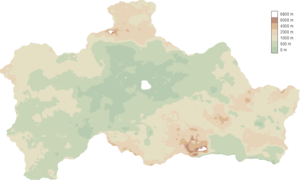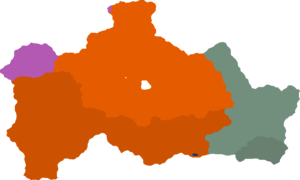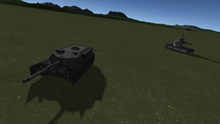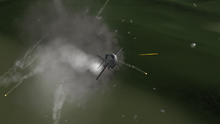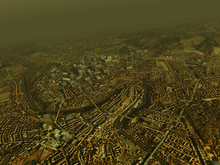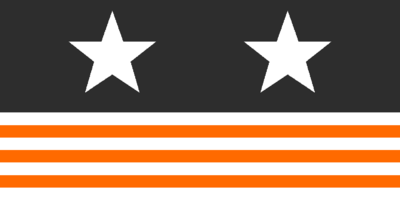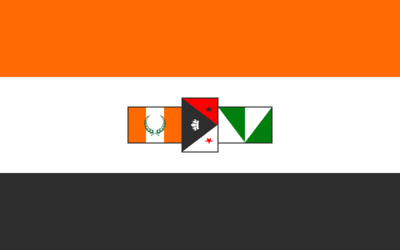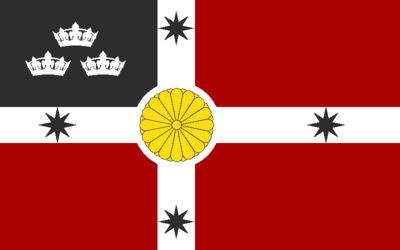Strelka: Difference between revisions
No edit summary |
No edit summary |
||
| Line 13: | Line 13: | ||
|government = Unitary Parliamentary Constitutional Monarchy |
|government = Unitary Parliamentary Constitutional Monarchy |
||
|foundation = |
|foundation = |
||
| − | 1764 (Dinsmark County) |
+ | 1764 (Dinsmark County)<br />2082 (Declaration)<br />2092 (Osini Federation)<br />2101 (Current Constitution) |
| − | |||
| − | 2082 (Declaration) |
||
| − | |||
| − | 2092 (Osini Federation) |
||
| − | |||
| − | 2101 (Current Constitution) |
||
|leader = |
|leader = |
||
| − | |ethnicity = 73% Krostanian |
+ | |ethnicity = 73% Krostanian<br />19.4% Kardanian<br />4.3% Blythe<br />2.3% Other |
| − | |||
| − | 19.4% Krakenary |
||
| − | |||
| − | 4.3% Blythe |
||
| − | |||
| − | 2.3% Other |
||
|population = 6,525,070 |
|population = 6,525,070 |
||
Revision as of 15:14, 17 July 2021
|
The Kingdom of Strelka
Strelkii
|
|||||
|---|---|---|---|---|---|
[[File: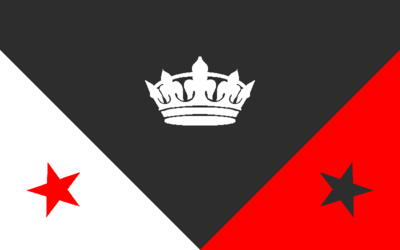 ]] ]] |
|||||
| Motto | "Die lug is nie die limiet nie" | ||||
| Common Name | Strelka | ||||
| Anthem | "May Our Monarch Reign Forever" | ||||
[[File: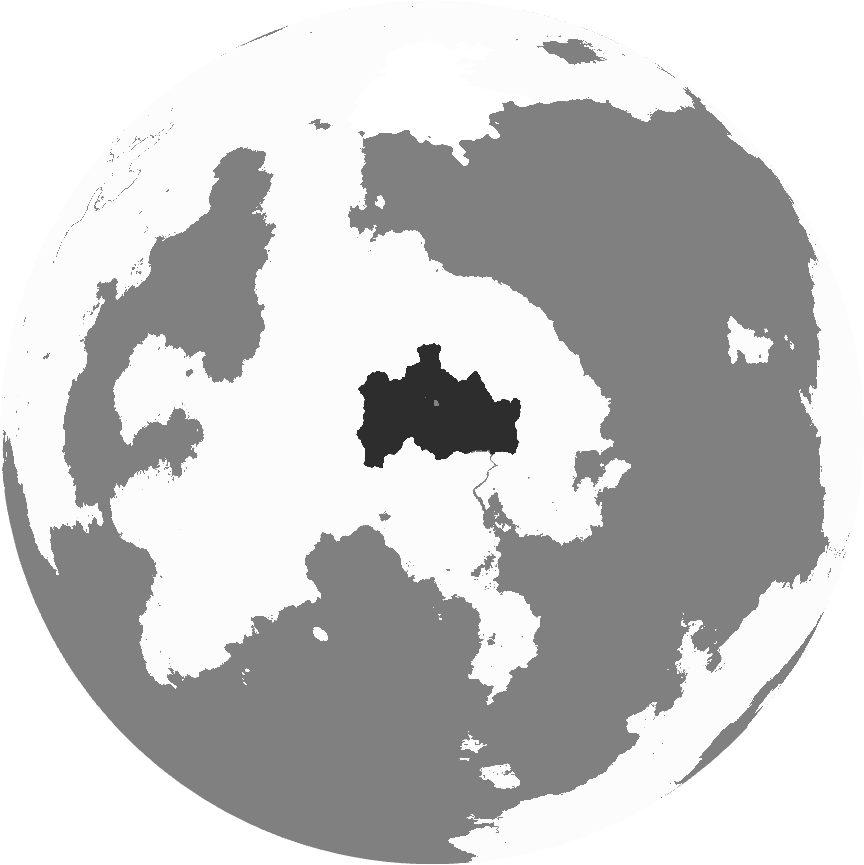 ]] ]] |
|||||
| Demonym | Strelkan | ||||
| Official languages | Strelkan, Kardanian | ||||
| Currency | Strelkan Round | ||||
| Politics | |||||
| Capital | Dinsmark | ||||
| Government | Unitary Parliamentary Constitutional Monarchy | ||||
| Foundation | 1764 (Dinsmark County) 2082 (Declaration) 2092 (Osini Federation) 2101 (Current Constitution) |
||||
| Preceded by | Vieno | ||||
| Followed by | Kurtzland,Strelkan Naval Junta | ||||
| Demography | |||||
| Ethnicities | 73% Krostanian 19.4% Kardanian 4.3% Blythe 2.3% Other |
||||
| Population | 6,525,070 | ||||
| Area | 31,409 km² km² | ||||
Etymology
###
Geography
The Kingdom of Strelka is a moderately sized landlocked nation located in central Kafrica, with its only coastal access being the Centrum River directly to the south. Consisting of six Strelkan states and a further two recently annexed Karlandic states.
Climate
Strelka has a largely moderate climate, experiencing cool weather throughout the year.
Biodiversity
###
Urban Areas
###
Politics
Government
The Strelkan government consists of two sections, the Royal Section, and the Parliamentary Section. The royal section over the years has lost some of its power, but still maintains a strong influence over parliamentary politics. It is made up entirely by royal family members, with the exception of monarchial advisors selected by the reigning monarch. The Royal Section must give approval via signature of the ruling monarch to any decrees passed by the parliamentary branch, before they are put into effect.
The parliamentary branch consists of 120 representatives, 15 per district within the country, and elections are held on representatives every two years. There are no term limits. These 120 representatives propose, discuss, and vote on various decrees which they then pass or decline. When passed, the decree must then be signed by the monarch ruling at the time, then is put into effect.
State Politics
State politics of the Kingdom of Strelka are similar to the national level. Lord are appointed by the reigning monarch to act as the royal branch of state politics, and representatives are elected by the kerbals to create state-wide laws. States have a large degree of autonomy, and once a lord has been selected, generally their royal line continues as the lord of that land indefinitely. The two most recently appointed lords, for the newly acquired Karlandic territories, are Vehnhaut of the Rogist dynasty, and Voltkain of the Thunjad dynasty, both Karlandic in ethnicity, it is hoped that they will help integrate the land quickly and effectively.
Political Parties
Currently, the Strelkan government has 6 active political parties in the parliament, all with varying positions. The largest party, the Liberal-Right party, is a conservative group that has held power since 1967. They've been the dominant influence in Strelkan politics for a long, long time, and generally the monarch is a member of the conservative party. They make up 76 of the parliamentary seats. The second largest party is the Center-left Coalition, a coalition party formed when the three major left-leaning parties of the country combined in order to more effectively combat the conservative one. They consist of 24 seats within the parliament. Third is the Strelkan National Front, a highly nationalistic party which gained brief popularity during the 1950s, after Comer seceded. They make up 13 seats. The remaining seats are all independent or industry influenced representatives.
Foreign Relations
The Kingdom of Strelka enjoys friendly relations with the UIF and their southern neighbour; Vocavium
Demographics
Languages
###
Education
###
Religion
###
Age
###
Military
Strelkan Royal Army (SRA)
The Strelkan Royal Army is the ground-based branch of the Royal Strelkan Military Forces (RSMF), consisting of tanks, APCs, anti-aircraft ground equipment, infantry, and many others. Currently, roughly 150,000 kerbs serve in the SRA. Strelkan doctrine has always placed a value of quality over quantity, and as such soldiers are trained extensively before being put into front-line service. The SRA is commanded by the High Royal General of Strelka, a position appointed by the monarch. currently Jonhat Vaughten, the king's son, is the High Royal General. Strelkan land doctrine is largely defense based, with most Strelkan constructs made to adapt to the surroundings of the Strelkan countryside. Strelka employs proven equipment made some time ago, and the SRA is in somewhat of a need for an upgrade. However, what they do have is utilized effectively, and a ground force upgrade program is currently being debated by parliament.
Strelkan Royal Air Force (SRAF)
The Strelkan Royal Air Force is Strelka's air based branch of the military. Founded in 1911, as one of the first dedicated air-forces on Kerbin, it is the pride and joy of the Strelkan Armed Forces. Utilizing highly advanced equipment, precise engineering, and painstakingly perfectionist development, the Strelkan air forces have claimed many victories around the world, with Strelkan's planes entering world conflicts before the nation itself existed in the international sense.
Economy
Taxation
###
Transport
###
Energy and Infrastructure
###
Trade
###
Science
###
History
Early History
Strelka was formed in the year 1764 after the Vaughten dynasty inherited the throne of nearby kingdom of Egerce. With newfound resources, the Vaughten dynasty moderately expanded throughout the area until encountering such nations as the Kingdom of Vieno, whom they had good relations with for some time. Known in the era for it's ruthless discipline in battle, and a refusal to accept other cultures within the nation, Strelka struggled considerably for some time due to unrest within its military conquests.
The Kingdom slowly lost land over time, until the nation was pressed to inhabit only the territory of Dismark in 2053, after considerable land losses to Vieno. Strelka experienced considerable economic strife in this period, and has remained a backwater nation in international politics ever since. In the late 2060s, the Tau Coalition was formed in order to combat the threat of the recently resurfaced Arcadian Union. Strelka was able to sell some designs to the Charlestonians and Zokesians, such as the F-156 Chickadee, who were both participating in the short Arkadii-Zokesian war at the time.
Following the Kroman Crusade of the late 70s and collapse of Vieno in 2078 the Kingdom experienced an expansion of its territory, coming to control Erkrol, Gdarski, and Algrachtus in only a matter of months. At the end of hostilities and with Oured now beyond Kroman control the nation took over administration of the area in 2079.
This was enough to give the country a small economic boost needed for development, and modern infrastructure was implemented throughout the country. Coal was switched to fusion, and the country has thrived since, opening its borders to the world recently in 2083.
The Great Kerbin War
Nearly immediately after its introduction to the international stage, Strelka joined the pan-national organization known as NEOCON in order to ensure that the nation remain secure until more secure footing could be gained. However, NEOCON shortly after declared itself to be the Greater Kerbin Union, and the Great Kerbin War began, thrusting Strelka directly into the middle of it as one of the sole NEOCON members in central Kafrica.
Immediately war plans were drawn up, and officers from Aenia were sent to Strelka through Karlandic airspace, before a blockade could be set up by the hostile powers. Strelka's land-locked status meant that the military didn't have to spend resources on a navy, and so the Royal Strelkan Army (RSA) and Royal Strelkan Air Force (RSAF) were deployed in defensive stances along all hostile borders, making it clear that the armed forces had no intentions to attack.
Following the open moves of the war, the nation of Greater Karland stated its intentions of defecting to the hostile powers, placing Strelka directly into the firing line of every single country around it. War Plan Tango was drawn up, and government continuity programs were established, as all Strelkan citizens prepared for the worst. War Plan Tango consisted of an immediate blitzkrieg through Karland in order to reach the ocean so that Aenian supply ships could reach Strelka before it was too late. Tanks began advancing through Karlandic land at a rapid pace, encountering no resistance, as the Karlandic military had retreated to defensive positions along their mountain ranges.
As this happened, The Third Way Alliance launched an asteroid attack against Aenia, hoping to deal an early blow against the superpower in the war. The Karlandic air-force took off, flying across the Tau Sea to Belasirov in order to help a combined TWA operation with the hopes of destroying the Aenian air force, and securing air supremacy over the Doren front of the war. However, Aenian forces retaliated, launching operation "Shadow Realm," and the two air-forces, consisting of over 2,000 air superiority fighters combined, clashed in the great blue skies above. The battle resulted in a decisive Aenian victory, and obliterated the entire TWA airforce, resulting in a humiliating retreat.
Following this catastrophe for TWA, all nations within it immediately surrendered unconditionally, including Karland. Three provinces were ceded from Karland to Strelka, including Karland's capital of Neu Burlen, and the process of integration into the country was started immediately. Following this, Strelka signed peace with KATO and the remaining allied powers, resulting in a somewhat hostile white peace.
Post War
Following the war, Neu Burlen was ceded back to Karland by the Strelkan government, who had been threatened with war by the newly formed Arkadii-Zokesian Federation should they not comply. This resulted in a loss of relations between Strelka and its NEOCON allies, as well as resentment from the people for dragging them into a massive war. Strelka promptly left NEOCON, and became one of the four founding members of KSAT, a new alliance between Kafrican nations, including Vocavium, Floracia, and Arad. Friendly relations are maintained with the UCF, the successor state to Aenia, and the two share an MDP.
